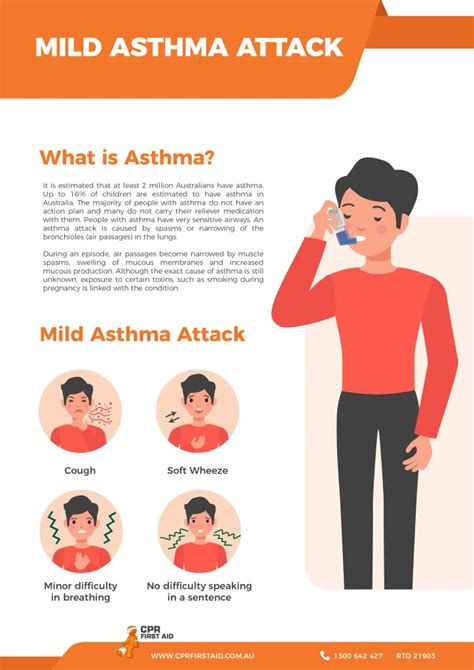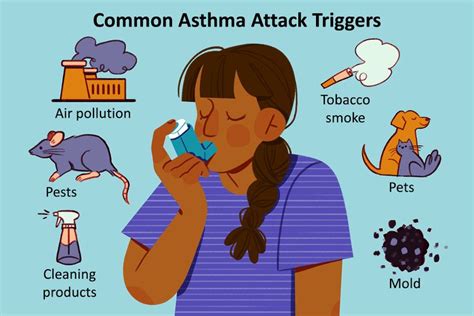Intro
Learn asthma attack symptoms, signs, and triggers. Understand wheezing, coughing, and shortness of breath, and discover treatment options for asthma management and relief.
Asthma is a chronic respiratory condition that affects millions of people worldwide, causing inflammation and constriction of the airways. When an asthma attack occurs, it can be a frightening and potentially life-threatening experience. Understanding the symptoms of an asthma attack is crucial for individuals with asthma, as well as their loved ones, to recognize the warning signs and take prompt action. In this article, we will delve into the world of asthma, exploring the importance of recognizing asthma attack symptoms and the steps that can be taken to manage this condition effectively.
Asthma attacks can be triggered by a variety of factors, including allergens, respiratory infections, air pollution, and physical activity. When an individual with asthma is exposed to one of these triggers, their airways become inflamed and constricted, making it difficult to breathe. The symptoms of an asthma attack can vary in severity, ranging from mild to life-threatening. It is essential to recognize the early warning signs of an asthma attack, as prompt treatment can help prevent the condition from worsening.
The impact of asthma on daily life cannot be overstated. For individuals with asthma, everyday activities can become challenging, and the constant fear of an asthma attack can be overwhelming. However, with the right treatment and management plan, individuals with asthma can lead active and healthy lives. By understanding the symptoms of an asthma attack and taking steps to prevent them, individuals with asthma can reduce their risk of experiencing a severe attack and improve their overall quality of life.
Asthma Attack Symptoms

Severe asthma attack symptoms can be life-threatening and require immediate medical attention. These symptoms may include severe wheezing, coughing, and shortness of breath, as well as blue-tinged lips and fingers, confusion, and loss of consciousness. If an individual experiences any of these symptoms, it is crucial to call emergency services or seek immediate medical attention.
Recognizing the Warning Signs
Recognizing the warning signs of an asthma attack is crucial for individuals with asthma. These warning signs may include increased coughing, wheezing, or shortness of breath, as well as a decrease in lung function. By recognizing these warning signs, individuals with asthma can take prompt action to prevent the attack from worsening.Causes of Asthma Attacks

Common Asthma Triggers
Common asthma triggers include: * Allergens such as dust mites, pet dander, and mold * Respiratory infections such as the common cold or flu * Air pollution * Physical activity * Stress and anxiety * Certain medications such as beta-blockers and aspirinTreatment and Management

Asthma Action Plan
An asthma action plan is a written plan that outlines the steps to take in case of an asthma attack. This plan should include: * A list of medications and dosages * A list of triggers to avoid * A plan for monitoring lung function * A plan for seeking medical attention in case of an emergencyPrevention Strategies

Avoiding Triggers
Avoiding triggers is crucial for preventing asthma attacks. This can involve: * Using allergen-proof bedding and mattress covers * Removing pets from the home * Avoiding smoking and secondhand smoke * Avoiding strong chemicals and fragrances * Wearing a mask when outdoors to avoid air pollutionLifestyle Changes

Healthy Diet
A healthy diet can also help manage asthma. Foods that are rich in antioxidants and omega-3 fatty acids, such as fruits, vegetables, and fatty fish, can help reduce inflammation and improve lung function.Conclusion and Next Steps

We invite you to share your thoughts and experiences with asthma in the comments below. If you have any questions or concerns, please do not hesitate to reach out. Additionally, if you found this article helpful, please share it with others who may be struggling with asthma.
What are the symptoms of an asthma attack?
+The symptoms of an asthma attack can include coughing, wheezing, shortness of breath, and chest tightness. In severe cases, symptoms can include blue-tinged lips and fingers, confusion, and loss of consciousness.
How can I prevent an asthma attack?
+To prevent an asthma attack, it is essential to avoid triggers such as allergens, air pollution, and physical activity. Maintaining good lung function through regular exercise and a healthy diet can also help prevent asthma attacks.
What should I do if I experience an asthma attack?
+If you experience an asthma attack, it is essential to follow your asthma action plan and seek medical attention if necessary. This may involve taking medication, using a nebulizer, or seeking emergency medical attention.
